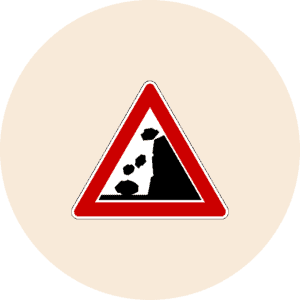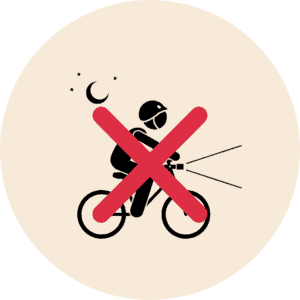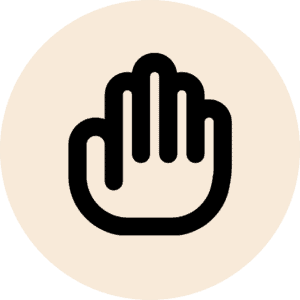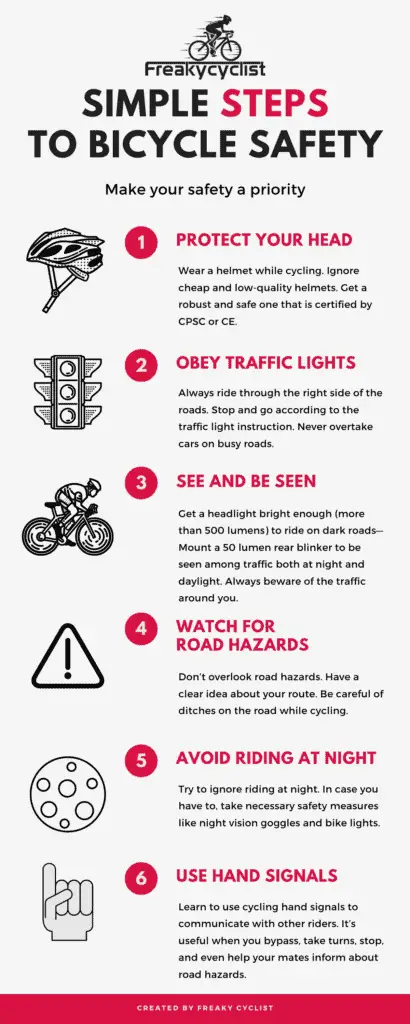Cycling is a popular mode of transportation in today’s world. For being an eco-friendly & healthy option, people are getting interested in bicycles. But, bicycling can be a nightmare if you meet an unpleasant crash. So, you should know about “bicycle safety.” Take necessary precautions and ride safely. We have brought six simple but vital steps for bicycle safety. Follow them so that you can save yourself from an unpleasant incident.
Step-1: Protect your head

The first step to bicycle safety is using a helmet. 70-80 percent possibility of head injuries can be decreased if you have worn a helmet during a crash. However, avoid cheaply made helmets. Get a CPSC or CE-certified helmet.
Anyways, a helmet should have the following features alongside certification.
- Robust and comfortable
- Should have an excellent fit
- Best quality straps and buckle
- Retain perfectly on the head
Besides these, advanced safety features like MIPS can be a great thing to ensure safer rides.
You might be interested in how to lock up a bike trailer
Step-2: Obey traffic rules

Most of the time, crashes occurred not for following the traffic rules. NHTSA has a clear guideline on how you should ride a bike. You should follow it properly. I am presenting those simply.
- Most of the roads have bicycle lanes. If your city roads have cycling lanes, ride through them. Otherwise, just go through the right side of the road.
- Follow the traffic signals. Stop and go when you are said to.
- Control your bike with at least a hand on the handlebar. Don’t take off both hands at a time from it.
- Don’t try to overtake cars. Ride behind the traffic flow on busy roads.
- You can also use a bell to alert other riders & pedestrians.
Step-3: See & been seen

Visibility is a crucial step to bicycle safety. Be careful about the traffic around you and also make you be seen among traffic. Do the following to see and to be seen.
- Watch out for cars behind you. You can use a mirror if you ride on busy roads. Always look out, before you take turns. Don’t rush; be careful about parked cars.
- Get a headlight bright enough (more than 500 lumens) to see dark roads. It also helps in foggy or cloudy weather. But, a must have for all night riders.
- Wear bright & reflective dresses while cycling. It will help other riders to see you among traffic. Oppositely, try to avoid faded colored dresses. You can also get a rear blinker of 50 lumens for being seen at both night and daylight!
Step-4: Watch for road hazards

It’s not always compulsory that you make a mistake to cause a crash. Sometimes, the other riders or the road hazards can be the actual culprit. Again, you can do anything to the reckless driving of the cars. What you can do is to be careful about them.
However, you should also watch for road hazards. So,
- Learn about your route before going out for a ride.
- Watch for ditches on roads and try to avoid them.
- Alert your riding mates behind by showing a hand signal.
Step-5: Avoid riding at night

Try not to ride at night. It’s risky to go out on dark roads, especially for mountain bikers. If it’s urgent, you can commute at night but take these precautions for safety.
- Don’t go out with sleepy eyes. Avoid cycling after you get high for alcohol consumption.
- Get a bright headlight so that you can see the road well. Make sure the light has a wider beam.
- Use a rear blinker and reflectors to be seen in the dark. Besides, wear reflective clothes for all-around visibility.
Step-6: Use hand signals

Hand signals are a useful way to communicate with other riders. Every country has developed some hand signals for cycling. Learn to use them and ride safely.
Bonus: Get some advanced protective gear
Besides all these above steps, get some protective gear too. They can enhance your safety & give you carefree rides. Moreover, you will feel ride-ready while wearing/using them. So, what to get?
Well, it depends on your need & the terrain you are riding on. But some of them are must-haves & I am giving you the list.
- Gloves: Increase grip and enhance control on the bike. Also, protect hands from a crash.
- Elbow & Knee Guards: Save you from joint injuries due to accidents
- Clothing: For full-body protection from a crash.
- Jacket: Suitable for mountain biking.
- Shoes: Increase control on pedals. Decrease the possibility of foot injuries.
If you want to get more familiar with our tips you can check out-
- How to Choose Bike in 2021
- How to Choose Bike Size In Just 10 Minutes
- Bike Maintenance: 5 Easy Steps for the Beginners
- How to Choose a Road bike? 5 Cool Bonus Tips Included!
We have a Graphical Representation of This. You can also check this out.
Conclusion
Sometimes the bike itself can be a threat to safe rides. So, besides those vital steps, take some preventive steps too. Check your bike before every ride and make sure the brakes are working well. Also, don’t forget to check the tires.
So, now you have learned about bicycle safety. I hope you will ride safely and enjoy your cycling life. And don’t forget to share this post with your friends.
Cheers!

